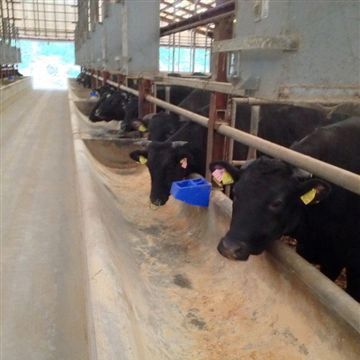Modern Japanese Selection
Contemporary prefectural sub-genomes continue to be identified by variation in genetic composition and performance characteristics between descendants of five major Japanese Black sub-populations, which evolve from the once- isolated Japanese prefectural herds of Hyogo, Tottori, Shimane, Okayama, Hiroshima etc – See Key Black Wagyu Bloodlines on this site). In 2012 Japanese government descriptors for breed development, selection from specific subgenomes or strains is officially specified (NLBC 2012).

Overview: Japanese Selection Practice
Nationally available carcass data has most informed Japanese genetic progress since the 1960s. But although relying most heavily on both national market prices for outstanding breeding and in-herd carcass EBV feedback information, Japanese breeding decisions continue to leverage traditional prefectural traits. An important decision in predictive selection for a traditional Japanese breeder lies in specifying an appropriate ‘mix’. Japanese animal science studies since the 1980s have supported the persistence of prefectural genetic differences and reveal that Japanese breeding selection from the five key sub-genomes has varied substantially over the last 50 years, depending on the economic emphasis of the period and maintaining a balance between growth and meat quality.
Government sponsored systems today assist in the selection of new candidate AI sires from ongoing progeny test programs, run at a prefectural level, with accompanying specifications to maintain diversity. In recent decades, carcass EBVs derived from national Japanese Government carcass databases, updated continuously and analysed by BLUP, have provided the single most influential tool. Over 90% of fullblood feeder progeny are subsequently produced by AI, generally from a tiny sub-group of ‘most popular’ carcass EBV sires selected by the above means from an extensive national catalogue.
Snapshot of Japanese Predictive Tools
Modern Japanese selection and genetic development at all levels is informed ‘upstream’ from official carcass measurement at the end of the cycle(see a snapshot of standard JMGA parameters here). These formal Japanese grading standards assess numerous carcass traits before providing a single value to each carcass.
Field Progeny Testing: Official annual progeny testing at a prefectural level has been central to Japanese FB sire selection for decades. Feeder progeny of candidates are slaughtered early, and carcass values adjusted, to reduce overall sire selection time cycles. Japanese language details are available at the NLBC website. Details on this site under Modern Japanese Production Systems here.
BLUP Carcass EBVs: The most significant modern milestone in Japanese Black genetic development within Japan was the introduction of BLUP (Best linear unbiased prediction) in about 1991 to analyse national, official carcass data records. The resulting EBVs enabled identification of superior carcass-quality bloodlines, data which in turn informed the annual direct and indirect (progeny) test systems that produce a new annual crop of official Japanese AI sires. This national system could not be replicated outside Japan. Again, more details under Modern Japanese Production Systems here. The post-1991 BLUP period has seen a national producer focus on a tiny band of superior AI sires and the commencement of a sharp decline in genetic diversity within the breed (Nomura, Honda & Mukai, 2001). Nonetheless, carcass performance was substantially improved. Once the post-1991 EBV rush subsided, anecdotal evidence (and carcass market sire pedigree analysis) suggests that uptake of new, tested sires is slow – producer conservatism in shifting from proven genetics being a likely cause. None of the leading current Japanese sires are available outside Japan.
Phenotype EBVs: There is also no directly equivalent Japanese breeder ‘toolbox’ to BLUP-based Australian BREEDPLAN EBVs based on live animal (phenotype) measurement, although possible models have been suggested. (Kahi & Hirooka:2005).
Digital Carcass Imaging: In 2015, Japanese carcass marble score measurements are often completed by high definition digital camera analysis, which provides maximum objectivity and minimizes human subjectivity/error. This Japanese technology is now extensively deployed in Australian research and Wagyu carcass measurement.
Pedigree analysis & Ancestor Gene Retention: As evidenced in current Japanese Wagyu genetics catalogues, producers also continue to employ traditional visual assessment and multi generation pedigree/prefectural origin analysis ( described here as the ‘Japanese 16/16 system’); official Japanese sire ranking summaries compiled from slaughter data; and field progeny testing data. Of these, the pedigree analysis system is readily adaptable in the Australian or international context. Molecular tools are used in analysing traditional bloodlines to identify those selection candidates that retain important ‘founder’ genes.
Ultrasound: In contrast with Australian practice, ultrasound is infrequently used in Japanese assessment of live cattle for carcass trait prediction (see Kahi & Hirooka, 2005 :p2026), despite value being identified in the ultrasound measurement of live animals to help inform predictive systems.

Overview: Australian Selection Practice
In Australia, and in sharp contrast with Japan, very little Wagyu carcass data has been available to inform progeny prediction/ seedstock selection, up to the commencement of the AWA GEBV project. Feeder producers receive performance reporting on their own stock and can tailor herd development accordingly, but consolidated carcass data remains within confidential, proprietary feedlot databases, where competitive pressures ensure it will stay.
Major differences between Australian and Japanese Wagyu production occur in:
- Crossbreeding: Crossbreeding (XB) has been dominant in Australian Wagyu production from industry inception in the 1990s and today probably accounts for over 90% of all Australian Wagyu beef.
- Australian FB production is relatively small, with practices more aligned with Japan, but with reduced use of artificial breeding.
- Artificial breeding: There are major differences in artificial breeding use. AI production of FB feeders in Japan probably exceeds 90% – reflecting rigorous selection pressure. Conversely, AI joinings as identified by FB registrations in Australia have fallen substantially on an annual basis for several years to 2013. An important reason for reduced AI use is relatively lower profitability for Australian producers. Australia relies heavily on natural mating using FB herd bulls that necessarily (due to mating commencement at 2yo) lack actual progeny data.
Let’s Talk About Your Wagyu Breeding Plan
We'll Find the Right Wagyu Breeding Solution for You
Call us:
